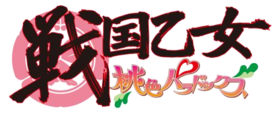Sengoku Otome - Momoiro Paradox
| Anime television series | |
|---|---|
| title | Sengoku Otome - Momoiro Paradox |
| Original title | 戦 国 乙 女 ~ 桃色 パ ラ ド ッ ク ス ~ |
| Country of production |
|
| original language | Japanese |
| year | 2011 |
| Studio | TMS Entertainment |
| length | 24 minutes |
| Episodes | 13 |
| genre | comedy |
| Director | Hideki Okamoto |
| idea | Heiwa |
| music | Eishi Segawa |
| First broadcast | April 5 - June 28, 2011 on TV Tokyo |
Sengoku Otome - Momoiro Paradox ( Japanese 戦 国 乙 女 ~ 桃色 パ ラ ド ッ ク ス ~ ) is an anime television series from 2011. It is based on the pachinko game Sengoku Otome , which was developed by Heiwa . The series was produced by TMS Entertainment under the direction of Hideki Okamoto and is about the girl Hideyoshi, who involuntarily moves from the present into the past, into the Sengoku era .
action
The very comfortable student Yoshino Hide ( 日出 佳 乃 , Hide Yoshino ), known as Hideyoshi ( ヒ デ ヨ シ ), was caught by her teacher again with being late and neglecting her school duties. In a conversation she is condemned to write an essay about the Sengoku period and the rise of the general Oda Nobunaga . Hideyoshi cannot be enthusiastic about it at all and on the way back from school is thinking about how she could spend her time “more meaningfully”. However, she hears a strange noise from a temple complex on her way. Following this and leaving alms, however, she witnesses a spell which she follows with interest. Falling out of curiosity into the room, from which a strange light shines, she is inadvertently sent by the conjurer to another world, which is similar to the Japan of the Sengoku period, albeit one populated exclusively by women.
There she finds herself in the midst of the tumult of battle and is quickly tracked down by Mitsuhide Akechi ( 明智 ミ ツ ヒ デ , Akechi Mitsuhide ) and suspected of espionage. Fortunately for Hideyoshis, Nobunaga Oda ( 織田 ノ ブ ナ ガ , Oda Nobunaga ) intervenes and can single-handedly defeat the opponent. In contrast to Mitsuhide, Nobunaga is well-disposed towards her and offers to accompany her to the palace.
Little by little Hideyoshi has to realize that she has really landed in another world, into which she does not really fit. Nobunaga takes a liking to her, however, because she makes such an unusual impression. It is similar for Mitsuhide, who, as Nobunaga's closest subordinate, cannot understand at all what leads Nobunaga to protect Hideyoshi so much. Hideyoshi accompanies Nobunaga in her attempt to find all parts of a legendary armor that - according to a belief - should be able to unite all of Japan under her rule as a complete set, and supports her with her unusual ideas.
In the background, the cautious to shy but manipulative Ieyasu Tokugawa ( 徳 川 イ エ ヤ ende , Tokugawa Ieyasu ) also tries to get hold of the complete armor.
Origin and publications
The anime television series Sengoku Otome - Momoiro Paradox was created in 2011, directed by Hideki Okamoto , who was also responsible for the storyboard, while Takao Machida wrote the script. The design of the characters was adopted by Shirogumi from the original game series and adapted for animation by Koji Yamakawa . The artistic direction was taken over by Nobuto Sakamoto from Bic Studio. The animation was directed by Kenji Fujisaki and Koji Yamakawa.
The series was first aired from April 5 to June 28, 2011 at night (and thus on the previous television day ) on TV Tokyo . In the following days, TV Hokkaido , TV Setouchi , TVQ Kyushu , TV Aichi , AT-X and TV Osaka also started broadcasting. As a simulcast with English subtitles, the series was also offered on Crunchyroll under the title Battle Girls: Time Paradox .
synchronization
| role | Japanese speaker ( seiyū ) |
|---|---|
| Hideno "Hideyoshi" Yoshi | Rina Hidaka |
| Nobunaga Oda | Megumi Toyoguchi |
| Mitsuhide Akechi | Eri Kitamura |
| Masamune date | Yuka Hirata |
| Kenshin Uesugi | Mariya Ise |
| Yoshimoto Imagawa | Rei Mochizuki |
| Ieyasu Tokugawa | Satomi Akesaka |
| Shingen Takeda | Sachi Kokuryu |
| Shiro | Nozomu Sasaki |
music
Eishi Segawa was responsible for the background music for the anime . The pieces of music used in the opening and closing credits were Kagerou ( 陽 炎 -kagerou- ) and Atsuki Ya no Gotoku ( 熱 き 矢 の 如 く ), both from Tenkatori-tai ( 天下 取 り 隊 , for example: "'Rulership over the whole country'- Troop "), d. H. the speakers of the characters Ieyasu, Kenshin, Shingen and Yoshimoto.
Web links
- Official Website (Japanese)
- Entry of the anime in the encyclopedia of Anime News Network (English)

